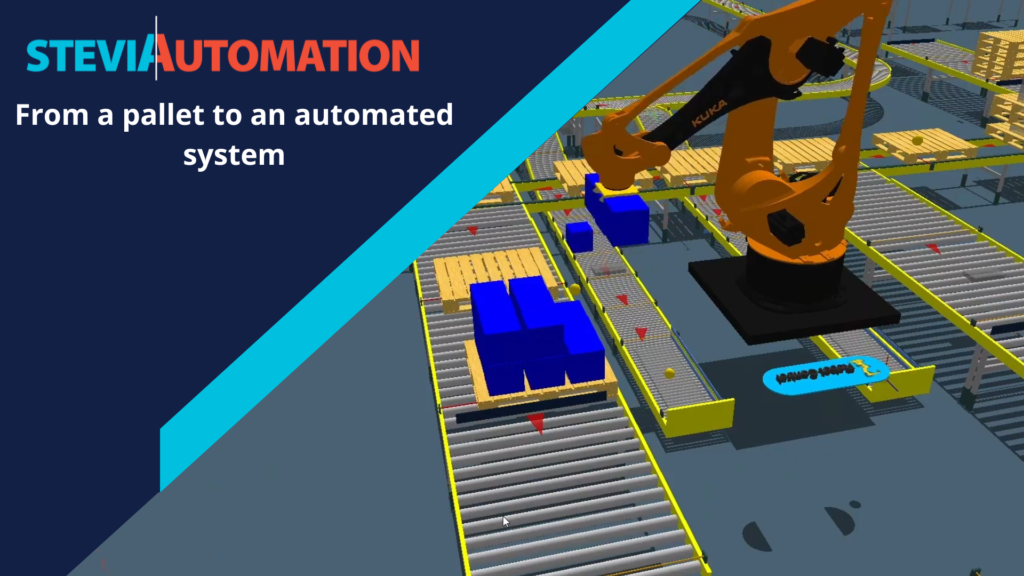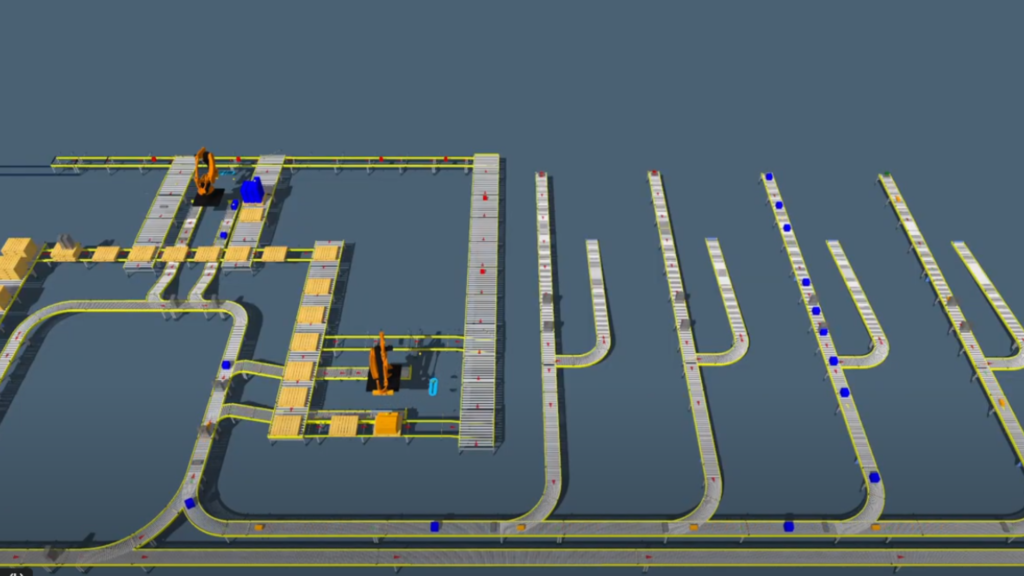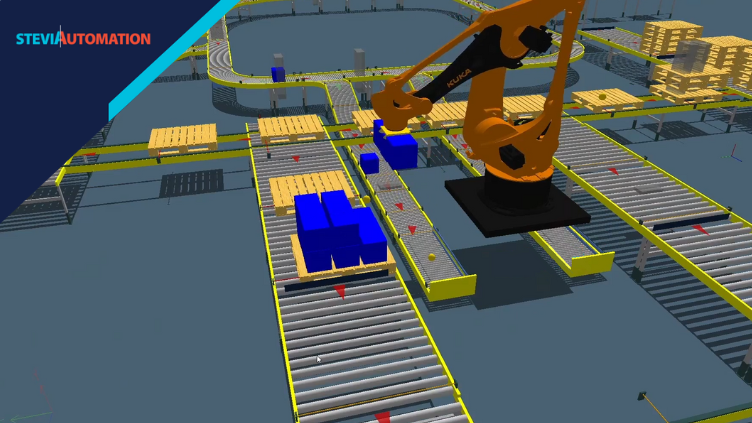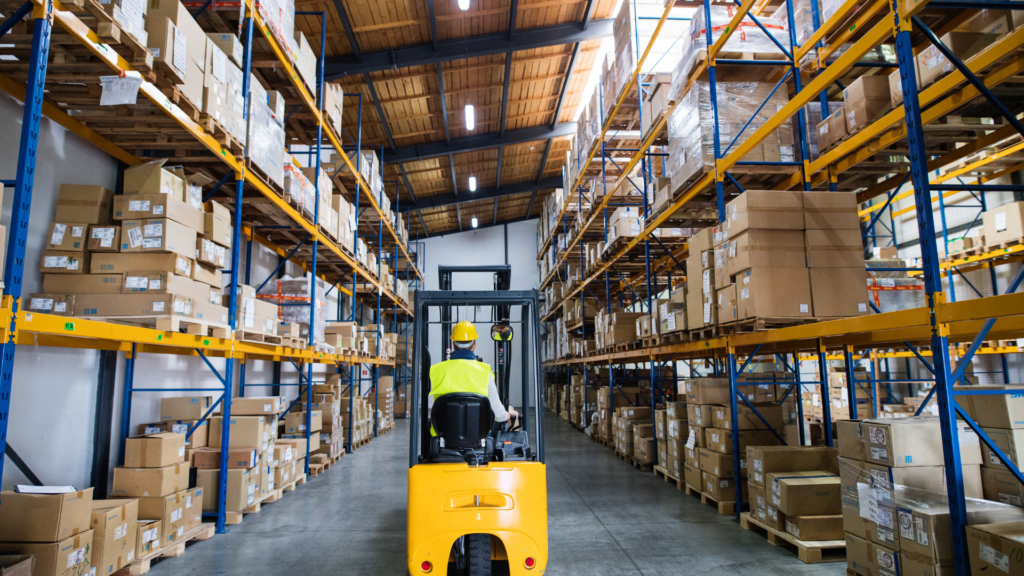Product palletization versus warehousing process
From a pallet to an automated system

Current logistic processes rely on the swift flow of goods and information between the sender, often the manufacturer, and the end customer. Warehousing is a crucial element of every logistic process. Within the warehouse, the order fulfillment, packaging, and shipping processes take place.
Products that are too large and heavy to be manually handled by warehouse staff are arranged on pallets for subsequent transport by forklift or other internal transportation systems. Prior to 1950, before the invention of the pallet by the Swedish company BT Industries, few would have anticipated that this unassuming wooden structure would become a key element in most logistic processes. Nowadays, pallets are manufactured according to European standards to ensure their applicability wherever they are used.
This material is dedicated to the palletization process. It is, in essence, the logistic process where goods are grouped and arranged on a pallet according to the order, creating a single load ready for transport.
Palletization involves assembling the ordered goods and placing them on the pallet according to customer requirements. The pallet with the assembled order must then be tightly and accurately packed and wrapped in film to prevent damage to the goods during transport in the warehouse or exposure to atmospheric factors.
The opposite of palletization is depalletization, which is the process of unpacking the pallet. Although both processes sound similar, depalletization differs from palletization in factors such as risk. The goal of depalletization in the context of the entire logistic process is also different. Depalletization is a more complex process involving the reception, compliance checking, and proper separation of the goods on the pallet.

Palletization and the challenges of modern warehouses
Every pallet of goods presents a challenge for modern warehouses. Primarily, it’s heavy and requires workers to utilize appropriate internal transportation systems, such as pallet jacks or forklifts.
Growing businesses receiving a large volume of orders sometimes struggle to meet rapid fulfillment. This can result in delivery delays, leading to financial losses for the company and reduced customer satisfaction. Implementing suitable processes and automation allows for work optimization and increased company efficiency.
One of the challenges for today’s warehouses is minimizing human labor, especially in areas where tasks are routine and repetitive. Automation is often a solution to such a problem, as it can reduce the costs of warehouse processes and improve employee comfort.
Another issue for modern warehouses is the rapid packing of various goods on a single pallet, known as “mixing palletizing.” The method of automating such palletization is still not fully refined. Manual palletizing of different types of goods on one pallet often presents challenges in correctly arranging the goods or shaping the packed pallet.

Automatic palletization as a modern warehousing solution
The use of pallets in warehouses is widespread because they are a unit load device that enables convenient loading and unloading processes. Pallets themselves facilitate the easier transportation of a larger quantity of goods from one place to another within the warehouse. By employing pallets, warehouse staff gain better control over the quantity and flow of goods, while warehouse space is utilized efficiently.
Due to the significant labor requirements and the heavy loads involved, an increasing number of businesses are considering how to streamline the palletization, depalletization, and intra-facility transportation processes. In the warehousing process, a pallet passes through several main warehouse zones, each of which may qualify for automation. The most critical warehouse zones include the receiving zone, storage zone, picking zone, and dispatch zone.
In the receiving zone, unloading and quantity and quality checks of goods occur to eliminate any potential damage that may have occurred during the pallet transport process or errors in the order. Subsequently, after identification, pallets are either unpacked or transported to their destination within the warehouse via pallet conveyors. Goods from unpacked pallets are placed in temporary containers, which are then moved to the storage zone. There, they await allocation to specific orders in the appropriate location.
Upon receiving an order, the picking process begins. Goods stored in the storage zone are retrieved for specific orders and arranged on pallets. Attention must be paid here to minimize the risk of picking errors, so after picking, the products are checked again to confirm their compliance with the actual order through scanning the picked items.
After the check, pallets with orders are transported to the dispatch zone, where they are loaded for the appropriate destination. The loading process onto the transport vehicle occurs, resulting in the order leaving the warehouse on a pallet.
In small, underdeveloped warehouses, the process from receipt to dispatch relies on manual transport and manual pallet packing/unpacking by workers. Manual or semi-automatic pallet jacks or forklifts are used for internal transport between warehouse zones. Such a setup serves its purpose in a small warehouse but can be physically demanding for workers. With an increase in orders, a fully manual warehouse may not be able to ensure that all orders are prepared on time and with the necessary accuracy, which can negatively impact the company’s reputation.
Therefore, in each warehouse zone, it is possible to implement methods to support the process of automatic palletization, depalletization, and internal pallet transport. In a manual warehouse, automation can begin with one zone initially, and after assessing the effects and benefits, move on to the next zones, eventually leading to full automation.
Applications of automation in modern warehouses
Implementation examples of automated palletization and depalletization systems are best illustrated through the lens of each warehouse zone. The receiving zone of the warehouse encompasses the unloading process of pallets from transport vehicles, as well as their unpacking and quality control.
Automation can already occur at the pallet unloading stage by using an automatic docking station. Connecting the vehicle to the automatic dock initiates the automatic unloading of goods. In advanced automation scenarios, pallets are transferred directly to pallet conveyors, which are programmed to direct each pallet to the appropriate location in the warehouse. Based on data from higher-level systems such as Warehouse Management Systems (WMS), pallets can be redirected directly to the appropriate depalletization area or to the storage zone.
In some cases, such as in manufacturing companies, immediate unpacking of goods on pallets is necessary upon receipt to transport them to the production line. A depalletizing robot is a device that streamlines this process. It is used for lifting or retrieving goods from pallets and transferring them directly onto warehouse conveyor systems. Robots can be utilized for unpacking pallets containing the same types of packaging, such as cartons. A challenge in modern automation is developing a system capable of depalletizing various products on a single pallet (known as mixing palletizing). Palletizing robots can be employed in various warehouse-production systems. They are characterized by their speed and accuracy in recognizing and transferring goods. Investing in such an installation reduces plant costs, as there is no need to employ multiple workers for pallet unpacking. Additionally, work efficiency and production quality are increased.

At the robotized depalletization station, the pallet with goods is delivered by warehouse conveyors. Then, the goods are transferred by the robot onto subsequent conveyors, which transport them to the appropriate zones. Depending on the requirements, sorting of the products may occur after depalletization to ensure they reach the correct destinations.
The storage zone of the warehouse is where each individual item or entire pallets of goods are placed. Continuous internal pallet transport occurs there as new deliveries are received, and ordered goods on pallets are taken away to begin the picking and shipping process. In a modern, automated warehouse, forklifts or manual pallet jacks are replaced by industrial conveyors, carriers, or autonomous vehicles that transport the pallet.
An automated conveyor system or autonomous vehicles precisely transport the pallet to the designated location without human involvement. It is integrated with a Warehouse Management System (WMS) that coordinates the entire flow of goods. Pallets stored on pallet racks can be placed on or removed from the rack using automatic lifts, cranes, or stackers, allowing for vertical movement of pallets. Such lifts enable the construction of multi-level pallet racks, saving warehouse space and identifying the goods stored on them.
In the order picking zone, each item is packed onto a pallet destined for shipment. Two types of palletization systems can be distinguished. The first involves arranging products on pallets in various packaging and shapes, such as picking grocery items. In such cases, picking is challenging and mostly performed by humans, but automation helps optimize this task. Workers in the picking zone receive sorted products, and their only task is to arrange them on the pallet.
In the second case, occurring in manufacturing plants where pallets are assembled with products in packages of the same type, the most commonly used solution is an automated palletizing cell. Goods placed in packages, e.g., cardboard boxes of specific dimensions, are transported towards the palletizing cell by conveyor systems. One or several feeding conveyors are allowed, depending on the quantity and specifications of the goods. Through proper programming of internal transport devices, the goods reach the cell. The robot palletizer identifies the pallet and moves each package to arrange it on the pallet. The goods are arranged precisely and in accordance with the customer’s order. The robot can quickly handle packing multiple packages onto a pallet. This increases order fulfillment efficiency, accuracy, and timeliness. The palletizing robot can work continuously, eliminating downtime present during manual palletizing. The automated palletizing cell can be easily reconfigured for packing other types of goods.
After completion, the pallet is wrapped and secured for transport. A unique number is assigned to each pallet to determine its destination, which is then transported through industrial conveyors in the warehouse to the appropriate destination in the loading zone.

Summary
The advantages of automatic palletization are numerous, benefiting both companies and employees alike. Firstly, it enhances warehouse efficiency, speed, and consistency, streamlining both the inbound receiving process and the outbound order fulfillment process. Additionally, it ensures continuous operation in the warehouse as automated machines or robots do not require breaks or downtime, unlike human workers.
Secondly, by implementing appropriate internal transport control systems and robotic palletization, the operational costs of the facility are reduced. This is achieved by eliminating human errors and alleviating the physically demanding aspects of the work. As a result, employees can enjoy increased safety and improved working conditions, as they primarily supervise the machines with the assistance of proper training, rather than engaging in physically demanding tasks such as lifting heavy loads and arranging them on pallets.
Furthermore, automatic palletization enhances the precision and quality of goods packaging, thereby reducing the risk of damage during transportation or inaccurately completed orders reaching the customer. This ultimately leads to fewer customer complaints and reduced costs for the supplier. Neatly arranged goods on pallets are essential for the subsequent phase of the logistical process, namely the transportation of the order to the customer.
See also: Company general overview

